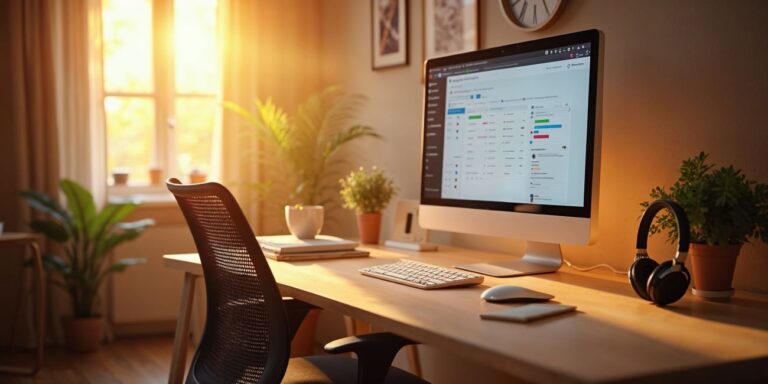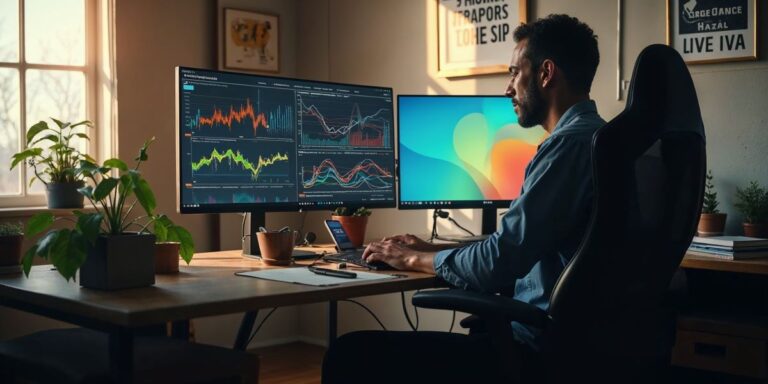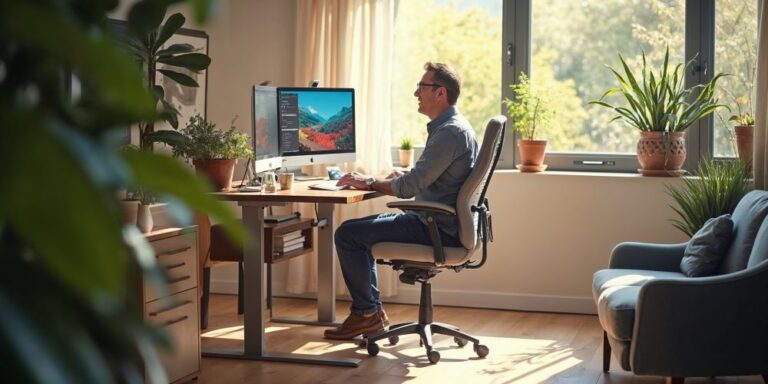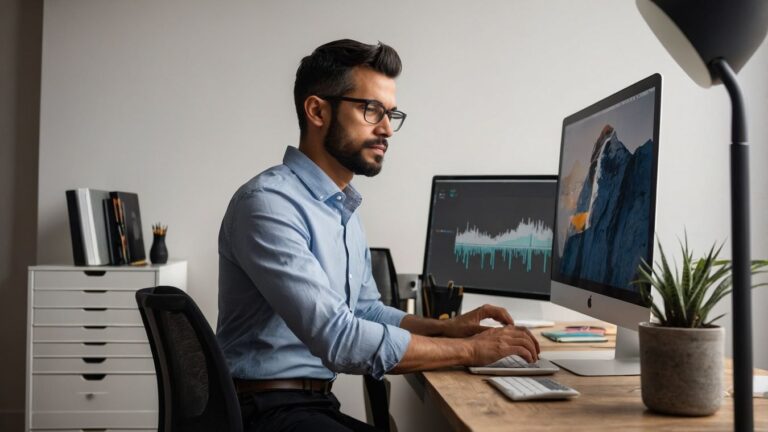Best Desk Setup for Home Office: The Ultimate Guide (2024)
Creating the best desk setup for your home office can transform your work-from-home experience. As someone who’s worked remotely for years, I know how crucial a good setup is. It’s not just about looks. It’s about boosting productivity and comfort.
Your home office desk is the heart of your workspace. It doesn’t matter if you have a whole room or just a corner. The right setup makes a big difference.
In this guide, we’ll cover it all. We’ll talk about ergonomic chairs and smart desk choices. We’ll look at lighting options and organization tricks. From budget-friendly ideas to high-end gear, we’ve got you covered.
A well-designed office isn’t just for show. It’s where you can focus and do your best work. By the end of this guide, you’ll know how to create your ideal setup.
We’ll explore standing desks and proper monitor placement. We’ll discuss the best chairs for long work sessions. You’ll learn about cable management and the right tech for your needs.
Lighting is key, so we’ll cover both natural and artificial options. We’ll also share tips on keeping your space organized and clutter-free.
Remember, a great home office setup is personal. What works for one person might not work for another. We’ll help you find what’s best for you.
Ready to upgrade your home office? Let’s dive in and create a space where you can thrive. Your perfect desk setup is just around the corner.
Another thing, before we start, let me remind you that this is a very extensive article as I am going to cover almost everything that is there to discuss to setup a home office, some points might seem irrelevant to you, but they might be extremely important to others, so you check out the table of contents first if you’re looking for something specific; otherwise if you’re an enthusiast like me then you can read it completely. I can guarantee you will find many things that you already don’t know or forgot to add. So let’s start
Understanding the Essentials for Best Desk Setup for Home Office

When I first started working from home, my “home office setup” was honestly just a mess. I threw together a desk, and an old chair, and called it good.
But, I quickly realized that a well-designed workspace isn’t just about throwing things in a corner—it’s about creating a space that helps you feel comfortable, focused, and ready to tackle your day. Trust me, a good setup can completely transform how you work.
Creating a space that balances workspace design with the remote work essentials you need isn’t just about looking good for Zoom calls (though, that’s a plus). It’s about finding a design that actually makes your day-to-day easier and boosts your productivity.
And hey, if it also helps you separate work from life when the day is done, that’s a win too.
What Defines the Perfect Home Office Desk Setup?
Let’s be real, most of us didn’t give much thought to ergonomics until we had to sit at a desk for eight hours straight. The perfect home office desk setup doesn’t just look good—it should feel good too.
When I first invested in an ergonomic desk setup, the difference was night and day. Suddenly, my back wasn’t aching, and I wasn’t constantly shifting in my seat, which meant I could actually focus on my work.
Here’s the deal: a productive workspace is one where everything is designed with intention. It’s about comfort, efficiency, and yes, a little personal style.
For me, it was about finding a setup that made it easy to sit (or stand) for long hours without feeling like I was breaking down my body. That means having your desk at the right height, your screen at eye level, and maybe even a little green plant nearby to remind you there’s life outside of spreadsheets.
Key Components of a Functional Desk Setup
So what does a functional desk setup really need? After years of trial and error (and many sore backs), here’s what I’ve found to be absolute essentials:
Ergonomic Chair

Look, this is the big one. I can’t stress enough how important it is to have a chair that supports your back. It might be a splurge, but your spine will thank you later.
Height-Adjustable Desk
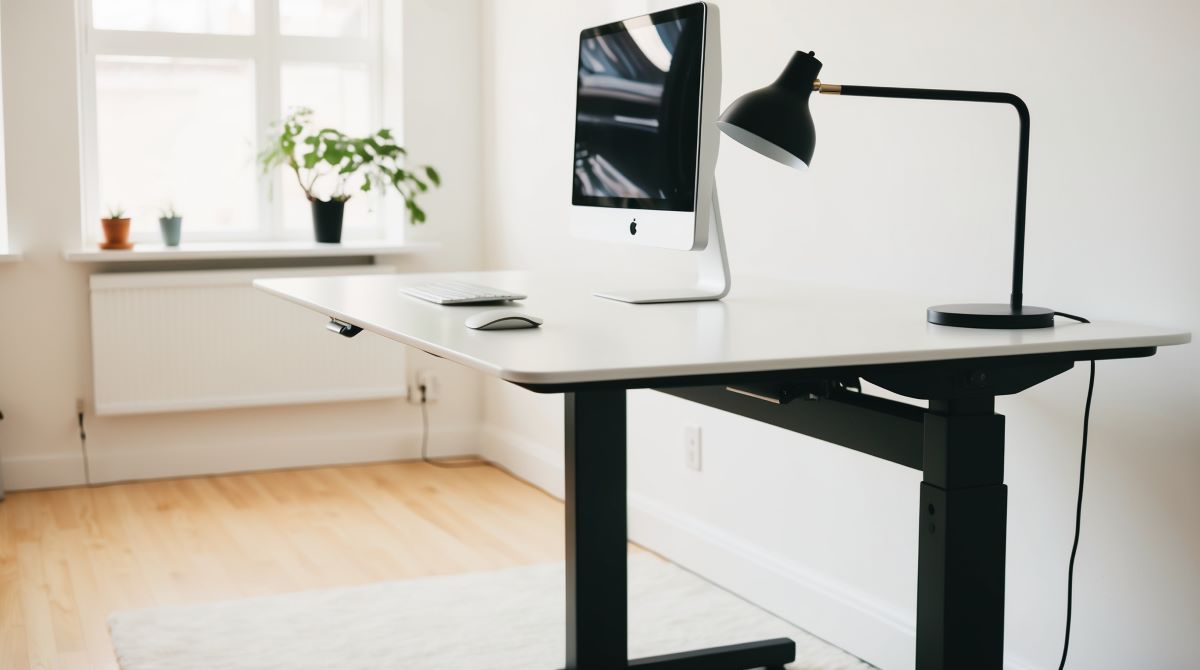
Sitting all day is a killer, not just for your productivity, but your body too. I invested in a sit-stand desk, and now I alternate throughout the day—it’s a game-changer.
Monitor Arm
You’d be surprised at how much a simple monitor arm can improve your posture. When your screen is at eye level, no more hunching over, which equals fewer neck problems.
Cable Management System
Okay, maybe this is just me, but a messy desk stresses me out. Keep those cables organized so you don’t spend half the day untangling cords.
Quality Lighting
Natural light is the best, but if you’re like me and your desk faces a dark corner, a good lamp with adjustable brightness will make all the difference.
Noise-Canceling Headphones
If you’re sharing your home with a partner, kids, or even a barking dog, these are essential for getting anything done.
Trust me, these aren’t just “nice-to-have” items. Every one of them plays a role in maintaining a workspace that’s both comfortable and productive.
Evolution of Home Office Desk Setups
I remember back when working from home meant setting up shop on the kitchen table and hoping for the best.
Fast forward a few years, and the workspace setup has evolved dramatically. Remote work is no longer a luxury—it’s a norm. And the way we think about home offices has changed with it.
Back in the day, a home office was more of an afterthought. Today, with so many people working remotely full-time, we’ve seen a huge shift toward ergonomic design and personalized setups.
People are investing in their space—buying standing desks, upgrading to multiple monitors, and even incorporating smart tech to make the day more efficient.
So, what’s next?
The future of remote work is going to bring even more innovation. We’re already seeing home office setups that integrate AI, allowing for everything from voice-activated lighting to temperature control.
I can see a future where our workspaces adapt to us—automatically adjusting our desk height, reminding us to stand, and maybe even improving our posture with real-time feedback.
Pretty cool, right?
Choosing the Ideal Desk for Your Space

When it comes to finding the best desk setup for home office, it’s not just about picking the first desk that looks nice on Pinterest. It’s about designing a space where you actually want to sit down and get work done every day. Whether you’ve got a tiny corner of your bedroom or a dedicated room, the desk you choose can make or break your workspace.
The right desk helps you maximize workspace optimization and improve space utilization, making your home office a comfortable, productive haven. I’ve tested a variety of desks over the years—each with its quirks—so let me save you the trial and error.
Exploring Different Desk Styles for Home Offices
Let’s talk about desk styles. Picking the right type of desk depends on both your available space and how you like to work. Here’s a breakdown of the most common options, with a few tips from my own experiences:
Standing Desks
Honestly, this was a game-changer for me. If you’re the type of person who can’t sit still for hours, a standing desk is a must. Not only does it let you alternate between sitting and standing, but it also helps reduce the aches and pains that come from being seated all day.
I found that my energy levels stayed higher when I switched to standing for parts of the day—definitely something to consider if you’re struggling with productivity.
L-Shaped Desks
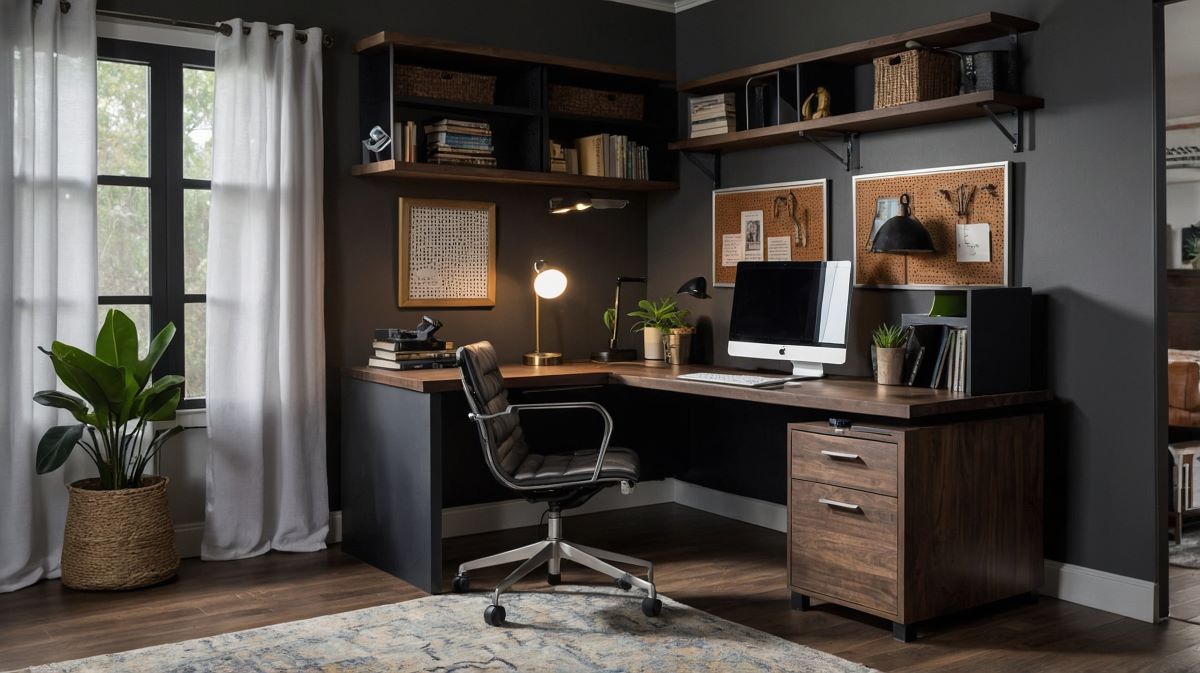
If you’ve got a bit more room to play with, an L-shaped desk can give you more surface area to spread out. I used one during a period when I was juggling multiple projects at once—it’s a dream if you’re using dual monitors or need space for papers, a laptop, and a desktop computer. Plus, it fits perfectly into a corner, which is a massive space-saver.
Writing Desks
These are great if you’re working in a small space or you just want something minimalist. A writing desk is typically more compact and has a sleek design, but it still provides enough space for your essentials. If you’re working with a laptop and don’t need tons of storage, this might be the best option for you.
Each of these desk styles offers unique benefits depending on your needs and space, and the right one can totally change how you feel about your workspace.
Key Factors When Choosing the Right Desk
Now, once you’ve decided on a desk style, you’ll need to think about some practical factors. You don’t want to order a desk only to realize it doesn’t fit your space or budget. Trust me, I’ve made that mistake, and it’s not fun.
Desk Size:
This is where you need to get your tape measure out! It sounds obvious, but knowing the exact dimensions of your available space is key. I once bought a desk that barely fit into my office—it was a nightmare trying to maneuver around it.
So make sure you leave enough room to move comfortably, especially if you’re adding a chair and other accessories.
Desk Material:
Choosing the right material is about more than just aesthetics. I’ve found wooden desks to be sturdy and long-lasting, while glass desks give a sleek, modern look but show every fingerprint.
If durability is important to you (and it should be if you’re like me and tend to spill coffee), you might want to stick with something like solid wood or metal.
Desk Budget:
I get it—desks can get pricey. But, you don’t have to spend a fortune to get something functional and stylish. Start with a budget and stick to it.
When I first set up my home office, I went with a budget-friendly desk that did the job, and later upgraded when I knew what I really needed. The key is finding something that balances cost with quality.
Top Desk Picks for Every Setup
I’ve been through my fair share of desks, and not all of them were winners. To save you from making the same mistakes, here are my top recommendations for different setups and budgets:
Best Overall Desk:
The Flexispot Standing Desk is a real all-rounder. It’s adjustable, so you can switch between sitting and standing whenever you need. It’s sturdy, reliable, and doesn’t break the bank.
Best for Small Spaces:
If you’re limited on space, the SHW Electric Height Adjustable Computer Desk is a great option. It’s compact, doesn’t dominate the room, and offers the flexibility of a standing desk without taking up too much space.
Best Budget-Friendly Option:
The FURINNO Econ Desk is a solid choice if you’re on a tight budget. It’s simple, functional, and perfect if you just need a basic setup without all the bells and whistles.
Best for Multi-Monitor Setups:
If you’re like me and love having multiple screens, the Ikea Bekant is a spacious, sturdy option that gives you plenty of room to work. It also has a clean, modern look that fits nicely in any office space.
At the end of the day, the best desk for your home office is one that suits your workflow, fits your space, and makes you feel comfortable working every day. It’s about finding the right balance between function and style, without breaking the bank.
Whether you’re upgrading or starting fresh, investing in a desk that works for you will make all the difference in how productive and comfortable you feel in your home office.
Ergonomics: Designing for Comfort and Health
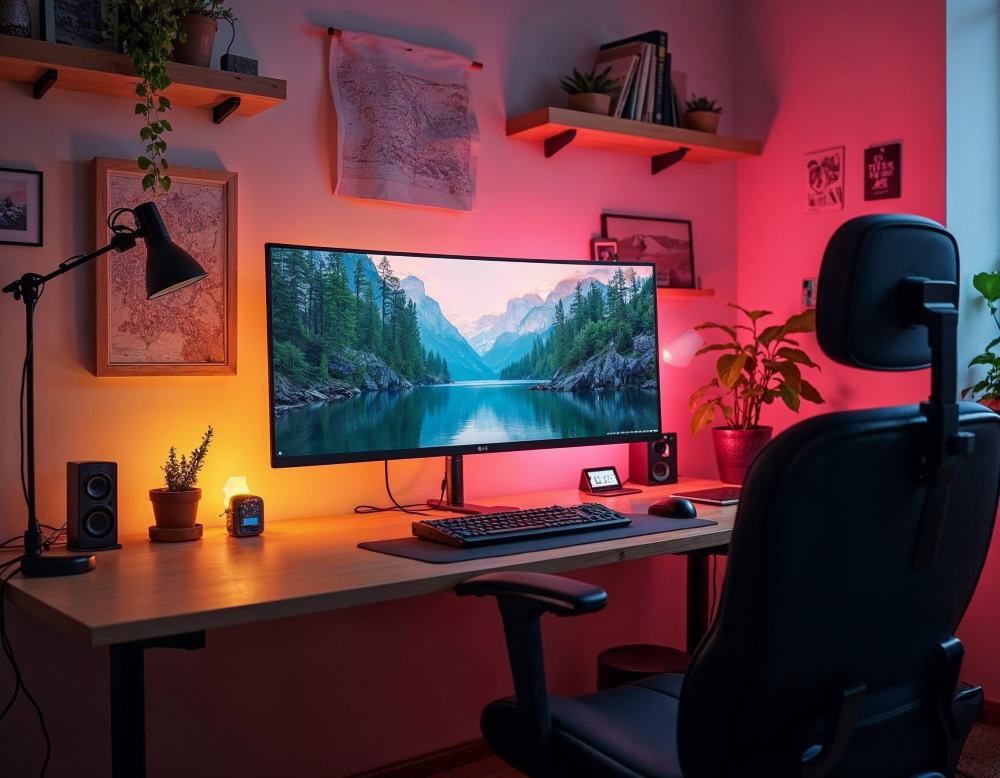
When I first started working from home, I never really thought about ergonomics.
I figured a decent chair and a desk would do the trick, but after weeks of sore wrists, back pain, and low energy, I realized that ergonomic home office design isn’t just a buzzword; it’s about designing a space that prioritizes both your physical well-being and productivity.
Trust me, your workspace can either make or break how you feel by the end of the day—and that’s not just physically, but mentally too.
Ergonomics isn’t about having the fanciest chair or desk. It’s about making sure that your setup supports you in all the right ways so that you can work comfortably and efficiently without pain or strain.
I’m here to break it down and show you how the right ergonomic setup can transform your home office.
Why Ergonomics is Critical in Home Office Design
So, why bother with ergonomics?
I learned the hard way that poor posture and bad seating can lead to workplace injuries like back pain, carpal tunnel, and chronic fatigue.
At first, I thought the discomfort was just part of sitting at a desk all day, but over time, these issues started affecting my focus and overall productivity.
What changed?
I invested in a few key ergonomic upgrades, and the benefits were almost immediate. Not only did my body feel better, but I noticed a big boost in my ability to concentrate for longer periods.
When your body’s aligned properly, you’re not constantly shifting around to get comfortable, which means you can focus on your work, not your pain.
Plus, these changes help prevent long-term health issues down the road, which is huge if you’re spending 40+ hours a week at your desk.
Core Ergonomic Elements for Any Setup
If you’re wondering where to start, here are the essentials I swear by after tweaking my own ergonomic home office over the years:
Ergonomic Chair:
This is where you should put most of your budget. A quality ergonomic chair with lumbar support, adjustable height, and a tilt feature will save your back. I used to sit on a regular dining chair, and after upgrading, the difference was night and day. No more back pain, and I could finally sit comfortably for longer hours.
Monitor Positioning:
Your screen should be at eye level—this is a game-changer. I used to hunch over my laptop all day, and it wreaked havoc on my neck and shoulders. With a monitor stand or arm, you can lift your screen so that you’re looking straight ahead. It sounds simple, but it can seriously reduce neck strain and improve your posture instantly.
Desk Height:
Ideally, your desk should allow your elbows to rest at a 90-degree angle while typing. I used to sit too low, causing my shoulders to tense up after just an hour of work. If you can get a height-adjustable desk, go for it. If not, you can raise or lower your chair and use a footrest to compensate.
Essential Ergonomic Accessories
Once you’ve got the basics down, a few accessories can make your setup even more comfortable. Here are the ones I recommend:
Wrist Rest
If you type a lot (and who doesn’t?), a wrist rest can make a huge difference. It keeps your wrists in a neutral position, reducing the strain on your joints. After adding one to my setup, I noticed less wrist pain, especially during long typing sessions.
Footrest
It might seem like a small detail, but a footrest can do wonders for your posture. If your feet don’t rest flat on the ground when you’re sitting, a footrest can help align your legs and reduce pressure on your lower back. I didn’t think I needed one, but once I tried it, I realized how much more relaxed I felt after a long day.
Ergonomic Keyboard
A regular keyboard forces your wrists into an unnatural position. I switched to an ergonomic keyboard, and it not only relieved wrist tension but made typing more comfortable overall. It’s worth the investment if you’re spending hours typing each day.
How to Organize Your Desk for Maximum Productivity
I used to think my chaotic desk setup was just part of the creative process—until I realized it was actually killing my productivity. When your workspace is cluttered, so is your mind.
Once I figured that out, organizing my desk became a game changer, not just for how it looked but for how efficiently I worked.
Here are some practical tips that transformed my workspace:
Cable Management:
One of the most important thing at least for me, and I think most of you will agree on this with me. Tangled cables drive me nuts, so I use simple clips and ties to keep everything tidy. It not only looks better but makes it easier to focus when there’s no visual clutter.
Desk Organizers:
I added a few drawer dividers and desktop organizers to keep my pens, notebooks, and other office supplies in check. When everything has its place, it’s easier to find what you need without breaking your concentration.
Shelving and Pegboards:
If desk space is limited, go vertical. I use a pegboard above my desk to hang items I need to access regularly, like headphones and cables. It keeps my desk clear and improves my overall workflow.
Organizing your desk space isn’t just about aesthetics—it directly impacts how efficiently you work. When everything has a place, you’ll find that your workflow becomes smoother, and you’ll spend less time rummaging through piles of clutter and more time focusing on the tasks that matter.
Creating a Minimalist Desk Setup
If there’s one thing that’s transformed how I work, it’s embracing a minimalist desk setup. I used to think more was better: more tools, more supplies, more stuff. But the truth is, all that clutter was doing more harm than good. After making a few changes to simplify my workspace, I realized how much more focused and productive I became.
Decluttering Tips:
The first step in achieving a minimalist office design is to remove everything from your desk. Yes, everything. Then, slowly put back only what you use daily. I stick to the essentials—a laptop, a notepad, a couple of pens, and maybe a plant for a touch of greenery.
Everything else?
It’s either in a drawer or gone. A clean desk means a clear mind, and that makes a huge difference when it comes to productivity.
Minimalist Office Accessories:
Just because you’re going minimalist doesn’t mean your desk has to be boring. The key is choosing accessories that serve a purpose without cluttering the space.
A sleek desk lamp, a simple pen holder, and a small notebook are all I need to keep my workspace functional and stylish. The beauty of a minimalist setup is that it helps you focus on your work instead of distractions.
Tech and Tools for a Future-Proof Home Office

Let’s face it—home office technology has become essential for staying productive in today’s remote work world. Whether you’re a full-time freelancer or someone working from home a few days a week, having the right tech makes all the difference.
I’ve fine-tuned my setup over the years, and trust me, it’s worth investing in tools that actually help you get work done without distractions. From choosing between a laptop or desktop to upgrading your workspace with smart tech, here’s everything you need to future-proof your home office.
Must-Have Tech for Modern Home Offices
When it comes to tech, the debate always starts with this: laptop vs. desktop. Here’s what I’ve learned. If flexibility and portability are important to you, a high-performance laptop is hard to beat. You can move around the house, or take it on the go if needed. But if you need raw power—think video editing, graphic design, or running multiple programs at once—a desktop with a dual monitor setup is a productivity beast.
Personally, I made the switch to a dual monitor desktop, and it’s been a game-changer for my workflow. With two screens, I can have my main task on one screen (writing this, for instance) while using the other for reference material or email. Once you go dual monitor, it’s hard to go back!
Audio and Video Gear for Remote Work
Let’s not forget about the virtual meetings that have become a daily part of life. If you’re still using your laptop’s built-in camera and microphone, it’s time to upgrade. I went for the Logitech C920 webcam, and the difference in video quality is night and day—no more grainy images or weird lighting. You look professional, and that’s important when face-to-face meetings have been replaced by Zoom calls.
For audio, noise-canceling headphones are a must-have, especially if you’ve got kids, pets, or noisy neighbors. I’ve been using the Sony WH-1000XM4, and they’ve saved me during countless meetings. They block out background noise and keep you focused, and the sound quality is excellent for both calls and music when you need to zone in.
Integrating Smart Technology into Your Workspace
This is where things get fun—smart home office tech. I’ve slowly been adding smart devices to my workspace, and the convenience is incredible. I use voice-controlled devices like Alexa to manage my day hands-free. Need to set a timer for a break? Just ask. Want to adjust the lighting without leaving your chair? Done.
Smart plugs are another favorite—imagine your coffee machine starting up as your computer powers on in the morning. It’s small touches like these that make your workday flow effortlessly. Integrating smart tech into your home office isn’t just about luxury; it’s about making your day more efficient and enjoyable.
Lighting Your Workspace for Productivity

If there’s one thing people overlook in their home office setup, it’s lighting. But believe me, home office lighting can make or break your productivity. Working under poor lighting strains your eyes and can even mess with your sleep cycle.
I used to work in a room with bad lighting, and by the end of the day, I was exhausted—not just mentally but physically. Once I upgraded my setup, the difference in my energy levels was unreal.
Why Lighting is Key to a Productive Home Office
The right lighting doesn’t just affect your mood; it directly impacts your ability to focus. Lighting and productivity go hand in hand. Ideally, you want as much natural light as possible, but if that’s not an option, artificial lighting can still do the trick.
Poor lighting causes eye strain and headaches, which can slow you down. On the flip side, bright, cool-toned lights mimic daylight and help regulate your circadian rhythm, keeping you alert during work hours. Personally, switching from dim, yellow lighting to brighter, white light boosted my productivity big time.
Best Lighting Solutions for Different Desk Setups
Here are some lighting options I’ve tested and recommend based on your specific setup:
Desk Lamps
If your desk is in a darker corner or doesn’t get much natural light, a high-quality desk lamp can make all the difference. I love using one with adjustable brightness and an LED bulb. You can direct the light exactly where you need it, reducing shadows and glare on your screen.
Smart Bulbs
For those of us who like to control everything with our voice or phone, smart bulbs are perfect. You can change the brightness or even the color depending on the time of day. I use bright white in the morning for focus and softer, warmer tones in the evening to help wind down.
LED Lighting Strips
These are great if you’re looking for ambient light that doesn’t take up desk space. I installed some LED strips under my shelves, and they give a soft, even glow that’s not too harsh. It’s a modern look that also makes late-night work sessions easier on the eyes.
Inspiring and Personalizing Your Workspace
When setting up your home office decor, it’s important to create a space that doesn’t just look good, but also inspires and motivates you to do your best work. Your workspace should feel personal and energizing—after all, it’s where you spend most of your day.
With a few thoughtful touches, you can transform a basic desk into a creative haven that enhances both your mood and productivity.
Using Color Psychology to Improve Focus
The colors in your workspace can have a surprising effect on how you feel and how well you work. Color psychology tells us that certain hues can either calm us down or give us a much-needed energy boost. For example, blues and greens are known for being soothing and great for focus, while yellows can spark creativity and optimism.
If you want to create a workspace that helps you get into a productive flow, think about how different colors influence your mood. For best colors for a home office, I’ve found that soft blues and greens are ideal for reducing stress and maintaining concentration.
On the other hand, adding a pop of bright yellow or orange can inject a bit of energy into the room, perfect for those days when you need a creative boost.
For a more neutral, professional feel, soft grays and whites work well, but make sure to add accents like colorful art or a plant to keep things from feeling too sterile. Ultimately, your home office decor should reflect both your personality and your productivity goals.
Personalizing Your Desk Space for Inspiration
Adding personal touches to your workspace isn’t just about making it look pretty—it’s about creating an environment that keeps you inspired and motivated. One of the easiest ways to do this is by adding office plants. Not only do they bring a bit of life and color to your desk, but studies have shown that plants can also reduce stress and improve air quality.
For a creative boost, consider incorporating motivational decor. I love having a framed quote or a vision board nearby—something that reminds me why I’m working hard every day. It could be a simple postcard, a photo of a place you want to visit, or even a sleek desk ornament that brings you joy.
Your desk space is where creativity happens, so make sure it reflects what inspires you.
Personalizing Your Desk Space for Inspiration
Adding personal touches to your workspace isn’t just about making it look pretty—it’s about creating an environment that keeps you inspired and motivated. One of the easiest ways to do this is by adding office plants. Not only do they bring a bit of life and color to your desk, but studies have shown that plants can also reduce stress and improve air quality.
For a creative boost, consider incorporating motivational decor. I love having a framed quote or a vision board nearby—something that reminds me why I’m working hard every day. It could be a simple postcard, a photo of a place you want to visit, or even a sleek desk ornament that brings you joy.
Your desk space is where creativity happens, so make sure it reflects what inspires you.
Desk Setups Tailored for Specific Professions
When setting up your professional home office, it’s important to consider how your workspace can be optimized for the specific demands of your job. Whether you’re a developer, designer, or financial analyst, your desk setup can either make your work smoother or become a daily frustration.
Optimized Desk Setups for Programmers and Developers
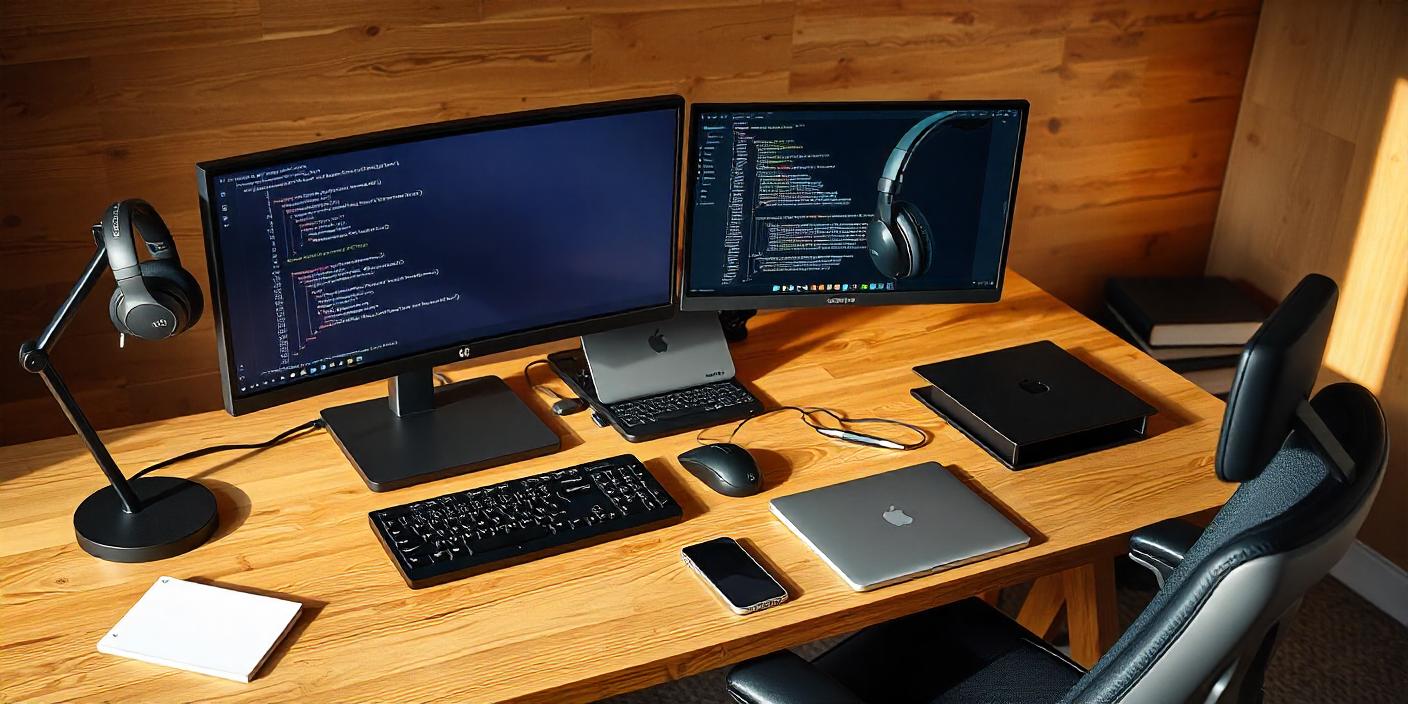
As a developer, your workspace needs to support long coding sessions and heavy multitasking. A multi-monitor setup is essential. With at least two screens, you can keep your code on one screen and documentation or communication tools open on the other.
For ergonomics, make sure you’ve got an adjustable chair and a keyboard that promotes a neutral hand position. Sitting for hours is hard on the body, so investing in an ergonomic chair that supports your back is crucial. A sit-stand desk is also a great idea if you want the flexibility to move throughout the day.
Another often overlooked tip: keep a minimalist approach to your workspace. Too many gadgets or papers can become distracting. Stick to the essentials—your monitors, keyboard, and perhaps a whiteboard for sketching out ideas. A clean, distraction-free coding workspace can help you stay focused on your tasks.
Home Office Desk Ideas for Creative Professionals
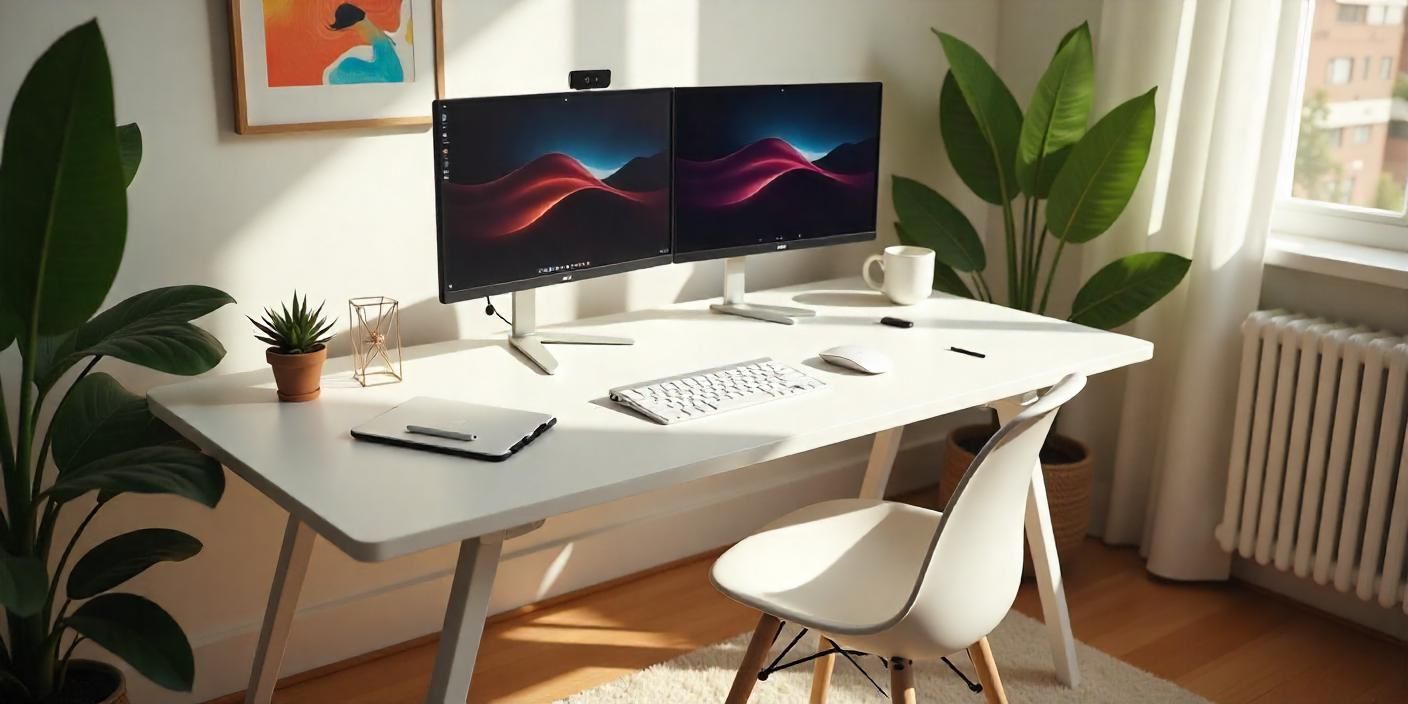
If you’re a graphic designer, video editor, or any other creative professional, your workspace needs to cater to both your creative flow and the technical demands of your gear. A graphic design workspace typically requires a large desk to hold your monitors, drawing tablet, and any other equipment.
For video editors or animators, a multi-monitor setup is also a must—one screen for editing, another for timelines or previewing content. Make sure your desk has enough space for all your equipment without feeling cluttered. Shelving or wall-mounted storage can help keep your desk clear while ensuring your tools are easily accessible.
Lighting is critical for creatives—natural light is ideal, but if that’s not possible, invest in good task lighting to avoid eye strain during long hours at your screen.
Desk Setups for Financial and Business Professionals

When you’re managing multiple financial reports, emails, and spreadsheets, a dual-monitor setup can make all the difference. Keeping financial data on one screen while conducting research or running business software on the other helps streamline your workflow.
Security is also key for financial professionals. If you’re handling sensitive information, make sure your desk setup includes space for secure storage, whether that’s a locked drawer or an encrypted external hard drive. Position your monitors strategically to prevent anyone from viewing confidential information over your shoulder, especially if you’re in a shared space.
In addition to a secure setup, keeping your business management workspace organized is crucial for efficiency. Use desk organizers to keep paperwork in order and reduce clutter so you can stay focused on managing important tasks without distractions.
Affordable Desk Solutions for Every Budget
Setting up a productive desk setup for the home office doesn’t mean you have to spend a fortune. Whether you’re starting from scratch or looking to upgrade, there are plenty of budget home office ideas that can transform your workspace without emptying your wallet. With a little creativity and resourcefulness, you can create a cost-effective workspace that looks great and helps you stay productive.
DIY Desks and Upcycled Furniture Ideas
Creating your own homemade desk is one of the easiest ways to save money while still achieving a functional and stylish setup. Plus, it adds a personal touch to your workspace that store-bought furniture just can’t replicate. Here’s how to get started:
Step 1: Find Your Surface:
Look for old doors, wooden panels, or even pallets that you can repurpose as a desk surface. Many people have used items like this to create a solid and stylish DIY desk. Sand it down, paint it, or stain it to match your decor, and voila—you’ve got a unique, budget-friendly desk.
Step 2: Repurpose What You Have:
If you’re working with limited resources, think outside the box. I’ve seen people use filing cabinets, bookshelves, or even crates to create a sturdy base for their desk. Not only does this save money, but it also adds storage space.
Step 3: Customize the Look:
Once you’ve built the frame, it’s time to get creative. Paint the desk to fit your style, or add decorative elements like hooks or wall organizers. The beauty of upcycled office furniture is that it can be tailored exactly to your preferences, all while being eco-friendly and budget-conscious.
This step-by-step approach can help you make the best desk setup for home office which costs a fraction of what you’d pay in stores.
Affordable Desk Accessories to Enhance Productivity
You don’t have to splurge to make your desk more functional. There are plenty of cheap office gadgets and budget ergonomic tools that can dramatically improve your workspace without breaking the bank. Here are a few to consider:
Wrist Rests and Keyboard Pads
If you spend long hours typing, a simple wrist rest can make all the difference in comfort and prevent strain. You can find these for less than $10, and they’re a small investment but trust me when I say this they delivers big results.
Laptop Stands
Elevating your laptop to eye level is crucial for preventing neck strain. A budget-friendly laptop stand can make a big difference, and you can even DIY one with a few sturdy books or blocks if you’re really keeping costs low.
Cable Organizers:
Messy cables can make your workspace feel chaotic. Velcro ties and cable clips are incredibly affordable and help keep things tidy. For just a few dollars, you can reduce clutter and improve your focus.
Chair Cushions:
Can’t afford an expensive ergonomic chair? No problem. A lumbar support cushion or seat pad can give you the comfort you need while still using your existing chair. These small upgrades make a big impact on your daily comfort and posture especially in the long run.
These low-cost accessories can significantly improve your workspace, making it both more functional and comfortable without a hefty price tag.
Maintaining and Upgrading Your Desk Setup
Once you’ve got your home office set up, keeping it well-maintained is key to ensuring it stays functional and fresh over time. Regular home office maintenance can help you extend the life of your furniture and tech, and make your workspace feel new even as your work needs evolve.
Regular Maintenance Tips to Keep Your Setup Fresh
Keeping your workspace clean and organized isn’t just about aesthetics—it can directly impact how well you work. Here’s a simple checklist to ensure your setup stays in top condition:
Clean Your Desk Weekly
Dust, crumbs, and clutter can pile up quickly. Set aside a few minutes each week to wipe down your surfaces, dust off your tech, and declutter. A clean desk not only looks better but also helps clear your mind.
Organize Your Cables
Every few months, revisit your cable management. Make sure wires are properly tied down and aren’t getting tangled. You can add new cable clips or ties if needed to keep everything streamlined.
Tech Maintenance
Regularly cleaning your keyboard, mouse, and computer fans will keep your equipment running smoothly. Use compressed air to remove dust from your keyboard and computer vents to prevent overheating.
Declutter Regularly
It’s easy to let papers, gadgets, and random clutter pile up. Schedule monthly decluttering sessions to keep your desk minimalist and organized. A clear workspace is a productive one!
By following this simple desk cleaning routine, you’ll keep your workspace fresh and functional, helping you stay on top of your game.
Troubleshooting Common Desk Setup Challenges
We’ve all faced those home office problems—whether it’s a lack of space, constant distractions, or just feeling like your setup isn’t quite right. But every problem has a solution, and with a little creativity, you can turn your workspace into a more functional and comfortable place to work.
Let’s dive into some common desk setup challenges and how to solve them.
Overcoming Space Constraints in Small Rooms
One of the biggest challenges when working from home is dealing with limited space. If you’re working in a small apartment or have only a corner of a room for your office, maximizing every inch becomes essential. Here are some small office ideas that can help you make the most of your space:
Compact Desk Solutions
Opt for space-saving desks like floating desks or foldable desks that can be tucked away when not in use. A wall-mounted desk can also work wonders in tight spaces, freeing up floor area and giving you more room to move around.
Vertical Storage
When floor space is limited, think vertical. Install shelves or pegboards above your desk to store office supplies, books, and even decorative items. This not only clears up your desk but also keeps your essentials within arm’s reach.
Multi-Functional Furniture
Look for furniture that serves double duty. For example, a storage ottoman that also functions as a seat or a desk with built-in drawers can save valuable space while keeping your workspace organized.
These compact desk solutions can help you create an efficient, comfortable workspace even in the tightest quarters.
Dealing with Distractions in a Home Office
Working from home has its perks, but one of the biggest downsides is dealing with distractions. Whether it’s household noise, family members, or just the temptation to check your phone, staying focused can be a challenge. Here are some home office focus tips to help you block out distractions and maintain concentration:
Noise Reduction Strategies
If noise is a problem, invest in a good pair of noise-cancelling headphones or try using a white noise machine. These tools can drown out background noise and help you stay in the zone. Alternatively, apps like Brain.fm or Noisli offer soundscapes designed to boost focus and productivity.
Create a Defined Workspace
If possible, designate a specific area for work and keep it separate from the rest of your home. This helps create a mental boundary between work and relaxation, making it easier to stay focused.
Use Time-Blocking Techniques
Breaking your day into focused work intervals followed by short breaks can help you stay productive. The Pomodoro Technique, for example, involves 25 minutes of focused work followed by a 5-minute break. This approach can help you power through distractions and stay on task.
With a few adjustments, you can turn your home office into a distraction-free zone where you can focus and get things done
Looking Ahead: Future Trends in Home Office Design
As remote work continues to evolve, so do the tools and designs that support it. The future of home offices looks exciting, with new technologies and innovations aimed at making our workspaces more efficient, sustainable, and even immersive. Here’s what to watch for.
Emerging Tech to Watch in Home Office Setups
As technology continues to advance, home offices are no longer just about desks and chairs—they’re becoming high-tech environments designed to improve both productivity and well-being.
If you are a tech enthusiast and love to update your home office desk with new upcoming gadgets, then this part is for you. Here are some cutting-edge technologies that may shape the future of workspaces:
VR and AR Workspaces:
Imagine working in a virtual office where you can interact with colleagues, attend meetings, and manage projects—all without leaving your home. Virtual reality (VR) and augmented reality (AR) are making this a reality.
Companies are already exploring VR offices that allow workers to collaborate in immersive environments, offering new ways to interact and work remotely.
Smart Desks and Workstations
Another emerging trend is smart office furniture. These workstations automatically adjust to your preferences, monitor your posture, and provide feedback on how to improve your comfort and productivity throughout the day. The future may involve desks that remind you to take breaks, adjust their height based on your activity, and even track your health metrics.
The integration of VR and smart technology will undoubtedly change the way we think about remote workspaces, offering a more dynamic and personalized work experience.
Eco-Friendly and Sustainable Home Office Setups

As the world becomes more environmentally conscious, there’s a growing demand for eco-friendly home offices. Designing a sustainable workspace not only benefits the planet but also creates a healthier environment for you to work in. Here’s how you can create a more sustainable home office:
Green Office Ideas:
Opt for furniture made from recycled or sustainable materials, such as bamboo desks or reclaimed wood. Choosing eco-friendly products reduces waste and minimizes your carbon footprint.
Energy-Efficient Lighting:
Switch to LED bulbs or smart lighting systems that adjust to the time of day and reduce energy consumption. Not only do they save energy, but they can also improve your overall work environment by providing optimal lighting conditions for focus and productivity.
Sustainable Office Supplies:
From refillable pens to recycled paper, there are plenty of ways to go green with your office supplies. Choose products that have a lower environmental impact and are designed for long-term use.
Creating an eco-friendly home office doesn’t have to be complicated. With a few simple changes, you can reduce your environmental footprint and create a healthier, more sustainable workspace.
Final Thought
So that’s it for this guide, I hope you like it. We have gone through some intense research to make sure we cover all the aspects for all type of users out there who are looking for a best desk setup for home office.
Creating your ideal home office setup is more than just assembling furniture—it’s about designing a space where you can work comfortably and stay productive. Whether you have a spacious room or are working in a small corner, the key is to make your environment functional, inspiring, and reflective of your personal style.
Choosing the right chair and desk that support your posture and reduce strain is an investment in your long-term well-being. It’s not just about avoiding back pain—it’s about keeping your energy and focus high throughout the day. Good lighting is just as important, as it helps reduce eye strain and boosts productivity.
If you’re working with limited space, don’t worry—there are plenty of small office ideas that can maximize every inch. From vertical storage to compact desks, there’s always a way to make the most out of your space without sacrificing comfort or efficiency. Keeping your desk organized not only makes your office look neat, but also helps clear your mind and keeps distractions at bay.
Personalizing your desk with motivational decor and a few personal touches like plants or photos adds a sense of comfort and inspiration. A workspace that reflects who you are can make you feel more motivated and connected to your work.
And remember, as your work evolves, so should your workspace. Regular home office maintenance, like decluttering and upgrading outdated tech or furniture, ensures that your office stays functional and relevant to your needs.
Whether you’re upgrading your chair for better back support or adding a second monitor for increased productivity, continuous improvement is key.
At the end of the day, building the perfect home office is about creating a space that helps you do your best work, day in and day out.
Affiliate Disclaimer
Some of the links in this post may be affiliate links. This means that if you click on one of the product links and make a purchase, I may receive a small commission at no additional cost to you. This helps support the blog and allows me to continue providing free content. Rest assured, I only recommend products or services I have personally used or researched thoroughly and believe will add value to my readers. Thank you for your support!



